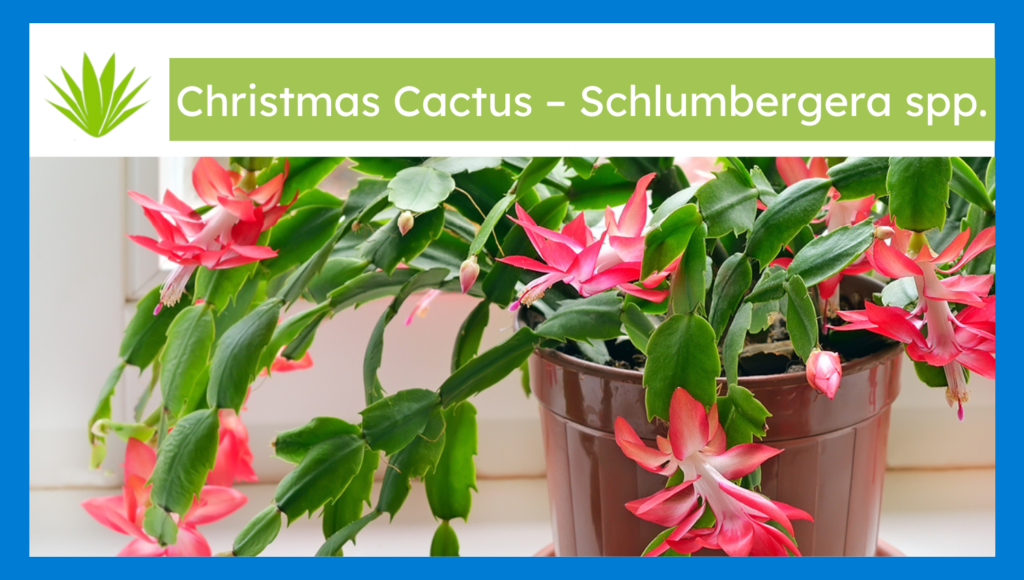| SR# | Characteristic | Description |
| 1 | Size | 1 to 3 feet tall. |
| 2 | Appearance | Pendant, branching stems with flat, segmented leaves. |
| 3 | Spines | Soft, not sharp. |
| 4 | Flowers | Bright pink, red, white, or purple blooms around Christmas. |
| 5 | Fruits | Small, red or purple berries. |
| 6 | Root System | Shallow, fibrous roots, suited for indoor environments. |
| 7 | Lifespan | 20 to 30 years, or more in cultivation. |
| 8 | Habitat | Tropical forests, often cultivated as houseplants. |
| 9 | Water Storage | Stores water in the stems. |
| 10 | Growth Rate | Moderate, can grow several inches per year. |
| 11 | Flowering Time | Winter, particularly around the holiday season. |
| 12 | Reproduction | Propagated through stem cuttings. |
The common tropical houseplant Schlumbergera spp. known as Christmas cactus has tubular flowers which typically appear during the Christmas season. Plants with flat, segmented green parts differ from desert cacti. They require moist areas with shade and have flat segments instead of spine-shaped parts.
The epiphytic plant grows in Brazil’s tropical rainforests by attaching itself to trees and rocks. Cacti grow best when they have adequate drainage in their soil, moderate ambient light exposure, and regular periodic fluids. Their striking delicate flowers include red, pink, white, and purple varieties which make them excellent festive decorating pieces. Properly maintained, these perennials produce vibrant annual blooms, creating a festive atmosphere in homes during the holiday season.
Table of Contents
How to Propagate a Christmas Cactus?
You need clean scissors to cut a healthy Christmas cactus stem for propagation into two to three segments. Place the cut portion in the open air for two days until a callus develops at the cut end to protect your plant from rot. Place the chromatic cutting into a confined pot with a mix of well-draining cactus compost. Set the callused end of the Christmas cactus one inch deep into moist soil before applying a tiny amount of water. Set your pot where sunlight is bright but indirect and maintain gentle moisture in the soil while having a strict limit against excessive water volume. After a few weeks, roots will appear and the cutting will transform into a new plant when maintained properly.
How to Care for a Christmas Cactus, including Watering and Repotting?
A proper growing environment for Christmas cactuses starts with bright indirect sunshine while keeping temperatures steady at 60-70°F. Check the soil’s dry surface and water your Christmas cactus until it drains well enough to avoid root rot. When flowers appear raise humidity either with plant misting or setting a tray of water near the plant. While spring through summer give the Christmas cactus a balanced water-soluble fertilizer by following the monthly application schedule. Transfer your cactus into a new pot once every 2-3 years after it surpasses its current container size you should do this step in spring. Select a plant pot with drainage holes while using fresh well-draining cactus mix soil. No hard handling should be performed on the plant because its thin stems and fragile roots are easily damaged.
What are the Uses for Christmas Cactuses?
People appreciate the decorative nature of Christmas cactuses together with their emotional value. Luxuriously colorful flowers that last long make them optimal decorative plants suited for holiday indoor use. These garden plants enhance workplace and household spaces by combining elegant colors with the organic features of their vibrant blossoms and healthy green stalks. People gift Christmas cactuses because they symbolize lasting friendships, resilience, and extended years. Its simple design and easy maintenance make them attractive options for gardeners across different knowledge levels. The ability of these plants to clean indoor air effectively makes them even more pleasing. When properly maintained, these cactuses can live for multiple generations and become cherished family possessions that can be passed down to generations.
Why isn’t my Christmas Cactus Blooming or Growing?
A Christmas cactus does not bloom or grow properly when kept in unfavorable care conditions. Windflowers fail to bloom because of insufficient lighting combined with uncorrected water practices or missing dark periods before flowering. The plant needs bright yet indirect sunlight combined with dark periods of 12-14 hours that should begin 6-8 weeks before flowering starts. Bad drainage and heavy amounts of water damage roots leading to root rot that harms plant size and overall wellness. The development slows when lightly watered or kept in areas with low humidity. During growth season fertilization with properly balanced nutrients helps fix growth-limiting factors. Solving these plant conditions restores both your Christmas cactus’s health and blooming capability.
Are Christmas Cactuses Poisonous to Cats?
Eating Christmas cactuses produces mild digestive problems such as vomiting or diarrhea in cats since these plants are non-poisonous to feline bodies. Monk-plant remains non-toxic to humans but participation by pets is discouraged to prevent both soil consumption and plant-eating incidents.
About The Author
Isaiah Espinoza
Isaiah Espinoza is the proud company owner, founder and driving force behind Legacy Landscaping and Design. Isaiah established Legacy Landscaping & Design in 2014, bringing his vision of creating stunning outdoor spaces to life. Isaiah, the founder of Legacy Landscaping & Design, has a deep-rooted passion for construction and design, stemming from four generations of family expertise in the industry. With a KB-1 General Building License and a CR-21 Hardscaping and Irrigation License, Isaiah has spent the past decade transforming outdoor spaces with exceptional craftsmanship and innovative design.

